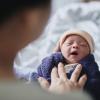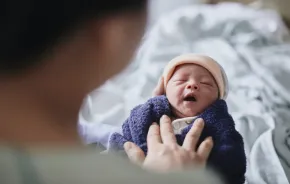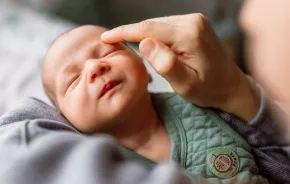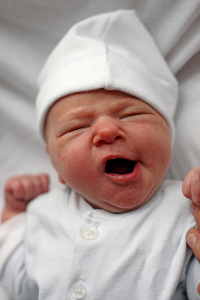 For many parents, the worrying begins the minute the pregnancy is confirmed.
For many parents, the worrying begins the minute the pregnancy is confirmed.
Conscientious mothers-to-be watch their diets and forgo alcohol. Once the baby is born, the worrying cranks up a notch. Is the baby eating enough? What about SIDS? Drowning in the bath?
With each stage, new worries nag. Crawling infants can choke on a sibling’s Legos. Furniture can be toppled as the toddler pulls on it to stand. The nightly news is filled with horror stories about small children who have been injured or worse in freak accidents.
Is it just sensational journalism? Or do we need to look at these incidents as tragic possibilities?
Kimberly M. Thompson, who directs the Kids Risk Project at the Harvard School of Public Health, notes that risks are real, though often much smaller than we assume. “People who worry about everything all the time should just relax,” Thompson says. “This worry may be restricting their relationship with their child, or curbing the child’s development and making them fearful about life and inhibiting exploration and growth.”
Does this mean we shouldn’t worry about freak accidents? Not quite, says Dr. Tony A. Woodward, medical director of emergency services at Children’s Hospital & Regional Medical Center in Seattle. “Almost anything you think of can cause a problem: falls from windows, dog bites, accidental shootings. Those things don’t happen often, but when it’s your child, it’s a tragedy,” says Woodward.
Both Woodward and Thompson feel it’s up to parents to be aware of all potential dangers and to take action to prevent injuries. The Centers for Disease Control (CDC) and Prevention Injury Center cites lack of supervision and improper use of equipment as the main causes behind the majority of accidental injuries to children.
Many of the real risks are ones we can reduce. Safe Kids USA, a national network of organizations dedicated to preventing accidental injury, finds that in 2002, the leading causes of accidental death in this country for kids ages 1 through 14 were auto accidents, choking, drowning, pedestrian injury and burns.
According to the CDC, many car accident deaths can be prevented. “Placing children in age- and size-appropriate car seats and booster seats reduces serious and fatal injuries by more than half,” the CDC reports. In one-quarter of those deaths, the CDC says on its Web site, the driver of the vehicle had been drinking.
What you can do
While you can’t prevent or foresee all auto accidents, you can use the proper car seat or restraints, put your child in the back seat, drive responsibly, maintain your car and obey the rules of the road. You won’t eliminate the risk completely, but you can lower it considerably. That same philosophy holds true for all of the other dangers, whether common, like drowning, or rare, such as swallowing magnets.
Woodward recommends using a designated watcher whenever small children are around water — whether it’s a pool, lake, stream or bucket. In movies, a drowning victim thrashes loudly and screams for help. In reality, small children sink silently, he notes. The parent who turns away to talk to a friend or runs inside to answer the phone may not realize the child is in danger until it’s too late.
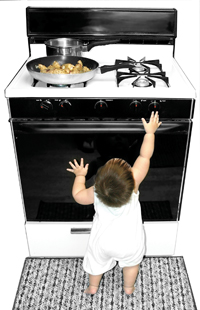 Vigilance can’t be replaced by water wings or inner tubes, which can give parents a false sense of security. “Don’t underestimate the power of attention — how aware you are of what’s happening in your child’s life,” Woodward says.
Vigilance can’t be replaced by water wings or inner tubes, which can give parents a false sense of security. “Don’t underestimate the power of attention — how aware you are of what’s happening in your child’s life,” Woodward says.
Begin baby-proofing your house before you bring your infant home, starting with recommended safety standards for cribs and bedding. The Puget Sound area has a number of businesses that can help you scrutinize your home and provide you with advice and products to keep your children safe as they grow and explore their world.
Be aware of choking hazards — food, small items, balloons. Learn to administer cardiopulmonary resuscitation (CPR) and the Heimlich maneuver to respond to the worst-case scenario. Courses are available through a number of private and public organizations.
The Internet abounds with safety information geared to every age. The government-funded Consumer Product Safety Commission (CPSC) offers a variety of resources on its Web site (www.cpsc.gov ). Sign up for email alerts of product recalls (see sidebar below).
As your baby becomes a toddler and ventures out into the world, extend your safety net. Public places require scrutiny, too. According to the CPSC, more than 200,000 children in the United States are treated yearly at hospital emergency rooms for playground equipment injuries. “At Children’s, we started calling the first day of school ‘Break Arm Day’ because we see so many playground injuries,” Woodward says.
Once you become a parent, you walk the tightrope of worry, teetering above irrational fear, balanced by common sense and an arsenal of information. Thompson sums it up: “Parents should not take action out of fear, but because they are well informed about their child’s risks — they know their kid better than anyone else.”
Andrea Leigh Ptak is a Seattle-based freelance writer.
Be prepared
Knowing CPR and other emergency procedures can mean the difference between life and death for your child. Classes are available from a variety of organizations around the Puget Sound area.
Red Cross
The local chapter of the Red Cross can teach parents how to perform CPR and the Heimlich maneuver.
Pacific Northwest CPR School
PNWCPR is the Northwest's premier provider of onsite CPR/first aid and automated external defibrillator (AED) training. Classes are offered days, evenings and weekends anywhere in the Puget Sound area.
Seattle Fire Department
The Seattle Fire Department offers free infant/child CPR classes. It organizes these classes once a year, or on an as-needed basis. To find one that is convenient for you, call 206-684-7274.
Know the risks
Awareness of potential dangers is the key. The following Web sites offer information on potential risks:
The Injury Prevention Program of the American Academy of Pediatrics
Baby safety
Safe Kids
Safe Kids raises awareness and teaches families about prevention of all major causes of accidental childhood injury.
Consumer Product Safety Commission
The CPSC is a national nonprofit dedicated to consumer safety.
Kids Risk Project
The Kids Risk Project of the Harvard School of Public Health





